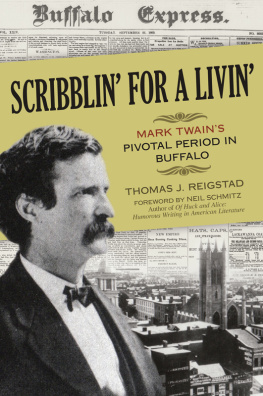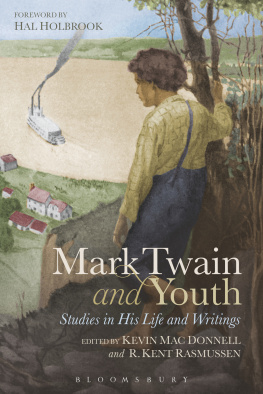Published 2013 by Prometheus Books
Scribblin for a Livin: Mark Twains Pivotal Period in Buffalo. Copyright 2013 by Thomas J. Reigstad. All rights reserved. No part of this publication may be reproduced, stored in a retrieval system, or transmitted in any form or by any means, digital, electronic, mechanical, photocopying, recording, or otherwise, or conveyed via the Internet or a website without prior written permission of the publisher, except in the case of brief quotations embodied in critical articles and reviews.
Every attempt has been made to trace accurate ownership of copyrighted material in this book. Errors and omissions will be corrected in subsequent editions, provided that notification is sent to the publisher.
Cover image of Mark Twain portrait by Upson and Simson, 1869,
from the Mark Twain Project, University of California, Berkeley
Cover image of C. L. Pond aerial photograph,
courtesy of the Lower Lakes Marine Historical Society
Cover image of Buffalo Express from the Buffalo and Erie County Historical Society;
Buffalo State College
Cover design by Jacqueline Nasso Cooke
Inquiries should be addressed to
Prometheus Books
59 John Glenn Drive
Amherst, New York 142282119
VOICE: 7166910133 FAX: 7166910137
WWW.PROMETHEUSBOOKS.COM
17 16 15 14 13 5 4 3 2 1
Library of Congress Cataloging-in-Publication Data
Reigstad, Thomas J.
Scribblin for a livin : Mark Twains pivitol period in Buffalo / by Thomas J. Reigstad.
p. cm.
Includes bibliographical references and index.
ISBN 978-1-61614-591-0 (pbk. : alk. paper) ISBN 978-1-61614-592-7 (ebook)
1. Twain, Mark, 1835-1910Homes and hauntsNew York (State)Buffalo. 2. Authors, AmericanHomes and hauntsNew York (State)Buffalo. 3. Authors, American19th centuryBiography. 4. Buffalo (N.Y.)Intellectual life19th century. 5. Buffalo (N.Y.)Biography. I. Title.
PS1334.R45 2013
818.409--dc23
[B]
2012044619
Printed in the United States of America on acid-free paper
This book is dedicated to the memory of my wife,
Maryanne LePage Reigstad

Foreword
by Dr. Neil Schmitz

Tom Reigstads prologue takes you on a walk through Forest Lawn Cemetery. The gravesites, the monuments, the family plots, are a Whos Who of Twains surprisingly extensive Buffalo social network, as the prologue tells us, and Tom moves respectfully among themSlee, Wadsworth, Jewett, Gray, to name severalgiving you exquisite thumbnail sketches of who they were and how they figured in Mark Twains Buffalo life. They are the truth of Mark Twains engaged convivial life in Buffalo; some friends, notably David Gray, became lifetime friends. The accepted literary opinion that Mark Twains time in Buffalo was miserable, that Buffalo itselfwith its hard, cold winter and its gray, snowbound daysweighed upon his spirit, that he was socially isolated (a canard first stated by Albert Bigelow Paine, Mark Twains Boswell, his official biographer, and generally repeated in canonical Mark Twain biography) is decisively corrected here, at Forest Lawn Cemetery, in Toms prologue. Yes, illness and death came to the newlywed Clemens/Langdon Buffalo family. There was misery in Buffalo, but Buffalo had nothing to do with it. In Buffalo there was also triumph and glory, Mark Twain entering Aladdins Palace at 472 Delaware Street (now known as Delaware Avenue); Mark Twain bringing out Innocents Abroad and beginning to write Roughing It; Mark Twain taking hold of his life and his career, an adult at last, though his wife, Olivia, called him Child.
Tom Reigstads research is exhaustive. This is it. There isnt any more to be said about Mark Twain in Buffalo. If you want to think about the subject or write on its issues, this is the book that is open before you. It is so rich in detail and exacting in identification that strange new questions begin to appear. Everywhere Mark Twain turned in Buffalo, he was talking to someone who was on Jervis Langdons payroll. How did he start writing Roughing It in Buffalo, and why, since the book celebrates the wildcat Confederate scoundrel he, at that point, in Buffalo, forever abjured? Hip Presbyterian and Episcopalian postCivil War Buffalo was greatly pleased to have this popular literary comedian as neighbor and friend. Mark Twain held forth as the star member of the Nameless Club, St. James Hall, Elmwood Avenue. He shook the hand of old Millard Fillmore, former US president and noble Buffalonian elder. He might have smoked a cigar with Grover Cleveland, ambitious young Buffalo politician. Esther McWilliams, young wife of J. J. McWilliams, a colleague and friend, sorted and made a list of Mark Twains dirty clothes, took them back and forth to the laundress, and handled the bill, as Tom tells us. Twain was an installed power at the Buffalo Expressco-owner, coeditor, and featured columnistand he wanted, at first, to redo the Express to make it an important newspaper. There were fine minds and good writers at the Express, including Josephus Nelson Larned, John Harrison Mills, Earl Berry, and others. Buffalo was there for him, to play with, to play in, to become a man of affairs. He was the young prince in Buffalo. Young Buffalo Presbyterian guys were thrilled to know him. Esther McWilliams did his laundry.
As Toms research reveals, there were only three holdouts in Buffalo who managed to resist the magnetism of Mark Twains celebrity, and they make an interesting combination of postCivil War figures, though of course they did not know each other. One was a wounded Civil War hero; the next, a radical feminist; the third, an African American janitor at the Express, each with a justified grievance. George Selkirk, in the field of the major battles at Antietam, Fredericksburg, and Gettysburg, twice wounded and twice decorated, no doubt took a certain measure of his new flamboyant and vociferous partner, resentfully heard that wildcat Confederate drawl. Did he know Mark Twains Civil War story? He did not. Mark Twain, in the years from 1869 to 1871, did not have a Civil War story he could tell. Mark Twain called Selkirk Colonel, no doubt with mock respect. When Mark Twain finally sold his interest in the Express, he bitterly sold it to Selkirk, suffering a ten-thousand-dollar loss. When Anna Dickinson, a midcentury cultural critic and public speaker, postabolitionist radical feminist, and old and valued friend of Olivia Clemens, visited Olivia in Buffalo, she found Mark Twain to be a vulgar boor. She, too, heard that drawl. It must have grated on janitor Philip Lees sensitive ear. And what about Mark Twains imperious manner? According to legend, Lee played dirty tricks on Mark Twain.
In Buffalo, it might be said, Mark Twain experienced his first unmitigated jubilation: he married the kings daughter. Jervis Langdon, Olivias father, was the coal king of Buffalo from 1869 to 1871, the years of Mark Twains residence. But who was Jervis Langdon? He was a magnate. He ran a big energy company, had investments and holdings, one of which was a prime piece of Buffalos waterfront that Mark Twain held to the end of his life. Langdon was the munificent father of the bride, got Mark Twain his first real job in the serious world of business and politics, bought the mansion at 472 Delaware, and furnished it with drapes and rugs, chairs and tables, so that all Mark Twain had to do was move in and be good.





![Twain Mark - Autobiography of Mark Twain Vol. 1 / associate eds. Benjamin Griffin ... [et al.]](/uploads/posts/book/210276/thumbs/twain-mark-autobiography-of-mark-twain-vol-1.jpg)



